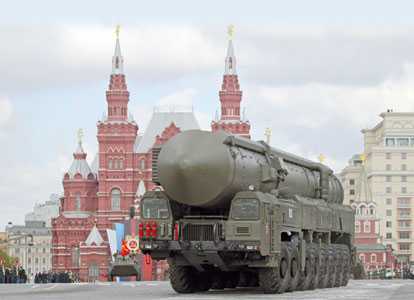Russia flexed its muscles in America’s backyard yesterday as it sent one of its largest warships to join military exercises in the Caribbean. The nuclear-powered flagship Peter the Great set off for Venezuela with the submarine destroyer Admiral Chabanenko and two support vessels in the first Russian naval mission in Latin America since the end of the Cold War.
“The St Andrew flag, the flag of the Russian Navy, is confidently returning to the world oceans,” Igor Dygalo, a spokesman for the Russian Navy, said. He declined to comment on Russian newspaper reports that nuclear submarines were also part of the expedition.
The voyage to join the Venezuelan Navy for manoeuvres came only days after Russian strategic nuclear bombers made their first visit to the country. Hugo Chávez, the President, said then that the arrival of the strike force was a warning to the US. The vehemently antiAmerican Venezuelan leader is due to visit Dmitri Medvedev, the Russian President, in Moscow this week as part of a tour that includes visits to Cuba and China.
Peter the Great is armed with 20 nuclear cruise missiles and up to 500 surface-to-air missiles, making it one of the most formidable warships in the world. The Kremlin has courted Venezuela and Cuba as tensions with the West soared over the proposed US missile shield in Eastern Europe and the Russian invasion of Georgia last month. Vladimir Putin, the Prime Minister, said recently that Russia should “restore its position in Cuba” – the nation where deployment of Soviet nuclear missiles in 1962 brought Russia and the United States to the brink of nuclear war.
Igor Sechin, the Deputy Prime Minister, made clear that Russia would challenge the US for influence in Latin America after visits to Venezuela, Nicaragua and Cuba last week. He said: “It would be wrong to talk about one nation having exclusive rights to this zone.”
Moscow was infuriated when Washington sent US warships into the Black Sea to deliver aid to Georgia after the war. Analysts said that the Kremlin was engaging in gunboat diplomacy over the encroachment of Nato into the former Soviet satellites of Georgia and Ukraine.
Pavel Felgengauer, a leading Russian defence expert, told The Times: “It’s to show the flag and the finger to the United States. They are offering a sort of gangland deal – if you get into our territory, then we will get into yours. You leave Georgia and Ukraine to us and we won’t go into the Caribbean, OK?” He described the visit as “first and foremost a propaganda deployment”, pointing out that one of the support vessels was a tug in case either of the warships broke down.
Latin America was one of the arenas of the Cold War in which the US and the Soviet Union battled for ideological dominance. Russia has agreed to sell more than $4 billion (£2 billion) worth of armaments to Venezuela since 2005 and disclosed last week that Mr Chávez wanted new antiaircraft systems and more fighter jets.
Mr Dygalo denied any link with Georgia and said that Mr Chávez and Mr Medvedev had agreed on the exercises in July.
Sea power
— In the Battle of Tsushima in 1905 – the largest naval battle since Trafalgar – the Russian fleet sailed 18,000 miles (33,000km) to Port Arthur in the Pacific, where it was outmanoeuvred and destroyed by Japanese forces
— During the 1962 Cuban missile crisis, the Soviet Navy conducted 180 voyages on 86 ships to transfer weapons to Cuba
Sources: Times Archive; russojapanesewar.com
The Times 23 September 2008


Leave a Reply